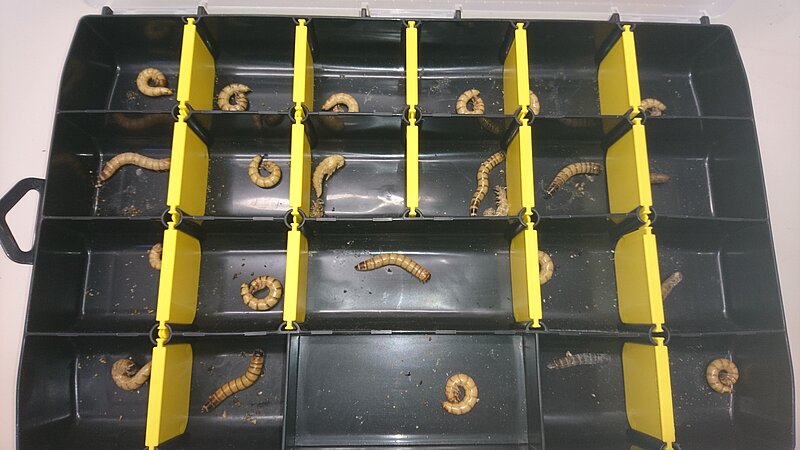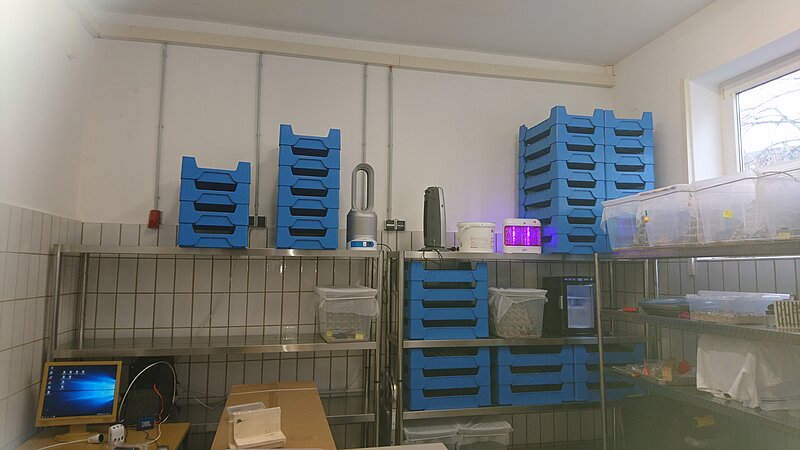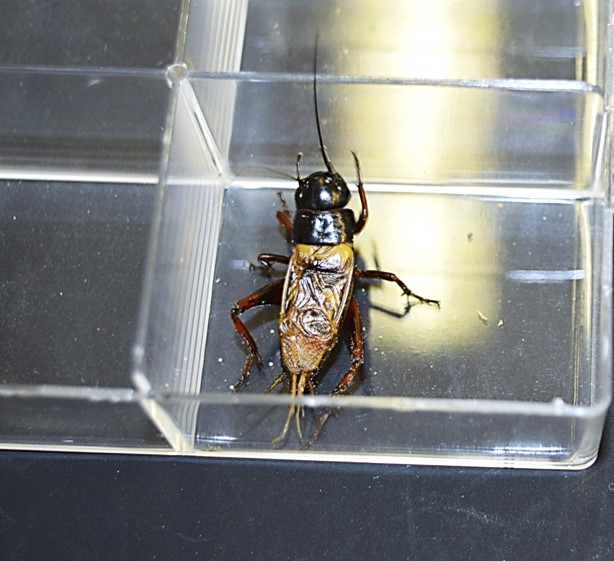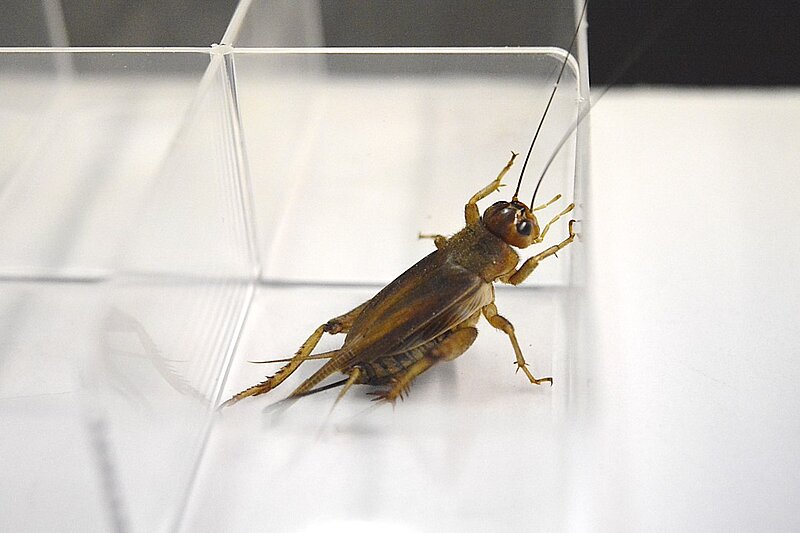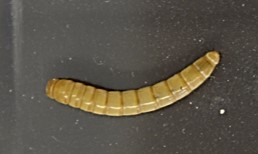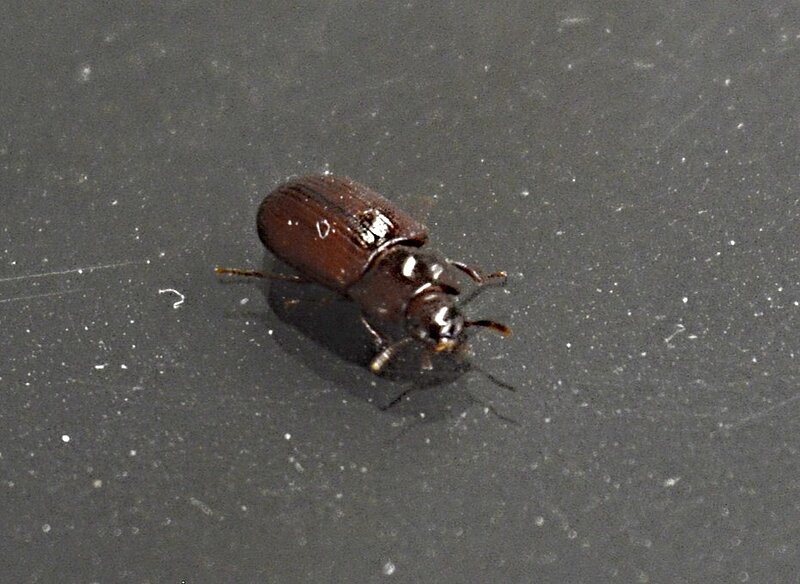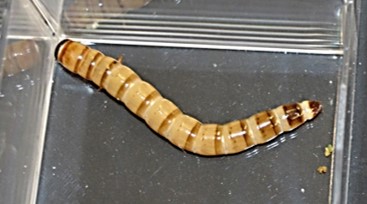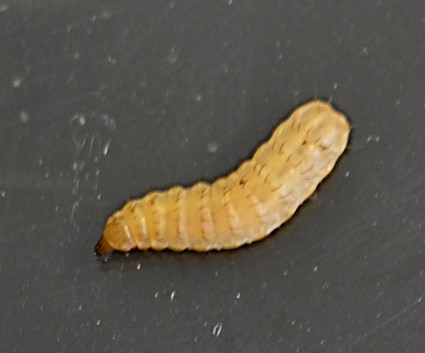The TiHo insectarium - Home of the “Krabbelkist”
The task of the LMQS insectarium is to keep and breed beneficial insects for research purposes. Since the focus of the IFNext project is currently on use, crickets and black beetles are mainly kept there. In addition, there is a small keeping of black soldier flies (Hermetia illucens). The "Krabbelkist" is the keeping and breeding box for crickets designed by IFNext (see below).
Why are beneficial insects kept?
The keeping of beneficial insects is actually not new, because feed breeders have been successfully keeping and breeding some species for decades in order to meet the needs of keepers of insect-eating pets.
Most of the insect species kept here can be used as food as well as food, so they are also edible for humans. Although a feed cricket has the same requirements for keeping as a food cricket, there are specific requirements for the breeding of food-producing animals that must be observed, especially in the area of hygiene.
The advantages of breeding over collecting in the wild are obvious for most species:
- Preservation of natural populations - but also protection of the animals that traditionally prey on these insects, e.g. birds, spiders, amphibians, reptiles, etc.
- Control over the production process, e.g. targeted feeding
- Consumer protection, especially in the area of chemical residues in the environment.
The TiHo insectarium offers the possibility of researching and documenting production cycles in a small space and serves as a model for larger farms.
Beneficial insects are currently bred around the world in four basic housing systems:
- Xiro culture: Keeping in a predominantly dry environment, e.g. crickets, grasshoppers and black beetles
- Hygro culture: Keeping in a predominantly moist environment, e.g. larval stages of the soldier fly
- Aquaculture: Keeping in aquariums or aqua terrariums, e.g. water bugs and beetles
- Xyloculture: keeping wood-eating species in trunks or buckets with chips from the host plant, e.g. bamboo borer (Omphisa fuscidentalis) or sago worms (Rhynchophorus ferruguineus)
In Germany, only the first two types of husbandry currently play a role.
Which species are kept in the TiHo insectarium?
Our animals belong to three larger groups:
- Crickets (Gryllidae): Together with grasshoppers and grasshoppers, they belong to an order of insects with around 28,000 species. Crickets have long antennae, a saddle-shaped breastplate on their back and a muscular third pair of legs. The chirping occurs when the males rub wings or legs together, which have comb-like ridges. Young crickets are called nymphs and already look like a miniature version of the adult immediately after birth, they shed their skin several times and then become adults who can reproduce (so-called hemimetabolism). Crickets are omnivores.
- Black beetle (Tenebrionidae): There are more than 350,000 species of beetles worldwide; most are characterized by a reinforcement of the first pair of wings with limited flight ability, while the second pair denies the actual flight. The young beetles are called larvae because they do not look like adults. This can also be found in normal language usage, because the larvae of Tenebrio molitor are called "mealworms", the adults are better known as "mealworms". The larvae become pupae, i.e. a dormant form in which the insect dissolves and reassembles itself again to become an adult beetle (so-called holometabolism). Black beetles are also omnivores. Interestingly, many are able to digest plastic because of the bacteria that reside in them.
- Gun flies (Stratiomyidae): The flies are part of the approximately 160,000 species of the two-winged species. Their wings have also changed. The animal flies with the first pair, the second has turned into so-called swinging bulbs and is used for orientation. Like beetles, flies are holometabolic, the larvae are also called maggots and are omnivorous.
Mediterranean cricket (Gryllus bimaculatus)
This cricket originally comes from the Mediterranean area, but is now also found wild as a feed insect in many countries. With a length of 2.2 to 3.0 cm and a weight of approx. 1 g, it is quite powerful for a cricket. The adult females in particular have two distinctive points on their almost black bodies on the beginnings of the first pair of wings.
Steppe cricket (Gryllus assimilis/locorojo)
Steppe crickets are about the same size as Mediterranean crickets, but originally come from the New World. Her abdomen is slate gray, the rest of the body in several shades of reddish brown. The three to four darker stripes that extend vertically from the occiput to between the eyes are characteristic. At the moment there is still a dispute among experts whether the steppe crickets that are kept as beneficial insects around the world are actually G. assimilis or the very similar looking G. locorojo (or both).
Mealworm, meal beetle (Tenebrio molitor)
Mealworms have been documented as cultural followers since the Bronze Age (approx. 5,000 years ago). Originally they lived in mulch and bird nests in the Mediterranean area, but are now practically spread all over the world and are also considered to be pests because they eat stored grain. Flour beetles are the prime example of taking advantage of a plague. The three different black beetle larvae (see below) are very similar at first glance, because they are all elongated and yellow-brown and with dark banding. Mealworms are medium-sized (2.5 cm for larvae, approx. 1.2 to 1.8 cm for beetles) and their banding is not as pronounced.
Buffalo worm, glossy black grain mold beetle (Alphitobius diaperinus)
This black beetle species probably comes from the African continent, inhabits animal structures, bird nests and bat caves, but has become a cultural successor just like the mealworm, but is a problem primarily as a pest in poultry farming. At 0.7 to 1.1 cm, Buffalo worms are slightly smaller and slimmer than mealworms and their banding is more prominent. The beetles usually measure 0.5 to 0.6 cm in length.
Zophobas worm, large black beetle (Zophobas atratus, ehemals „Zophobas morio“)
This species comes from the middle of the American continent and lives there in bat caves, so it is not a cultural follower. However, breeding has spread to all continents, as the larvae are 5 to 6 cm in length, stately appearances and are easy to breed. Unlike other beneficial insects, Zophobas worms rarely pupate in a community, but have to be kept separately in order to become a beetle 1.8 to 2.2 cm in length. They are therefore the largest of the three species of black beetle, and the larvae have particularly pronounced bands on the head and tail.
Black soldier fly (Hermetia illucens)
The soldier flies, also called BSF (black soldier flies), enjoy great popularity in the insect sector. In contrast to the crickets, the use of BSF goes back only to a small extent to a tradition. Rather, breeding was only developed in the last few decades, since the BSF larvae have a great appetite and, depending on what they are fed, can be used in a variety of ways, including reducing organic waste. Originally from South America, it is on the rise around the world. At first glance, adult flies look like a small, black and white wasp, and in fact they imitate a parasitic wasp, operating out of mimicry. Larvae are initially cream-colored, love it moist (hygro culture) and eat around the clock. With increasing age they get darker, stop eating and look for a dry environment in which to pupate (Xiro culture). The adult fly only lives for about eight days and drink water, but can no longer eat and live on its reserves from the larval period.
what is „Frass“?
Every livestock farming produces main products, but also by-products. In the case of insects, “Frass” refers to residues from keeping and breeding: insect droppings, fodder, moulting residues and dead insects, for example from the breeding colonies. This food is a technologically very interesting product that can at least be used as a fertilizer in plant cultivation.
what is a „Krabbelkist“?
We use this to refer to the box developed at TiHo as part of IFNext for keeping and breeding crickets for small businesses and beginners. It arose from the general procedure of keeping insects in terrariums or plastic boxes, but was expanded to include elements from the larger basins that are more common in Southeast Asia, e.g. the arrangement of egg boxes and the water supply. The crawling box is still manageable due to its size, and a standardization of the box equipment enables breeding under comparable conditions.
The name comes from the Low German language and comes from Krabbelderen (insects) and Kist (box, box).

